Huntingdon Valley
PA, USA
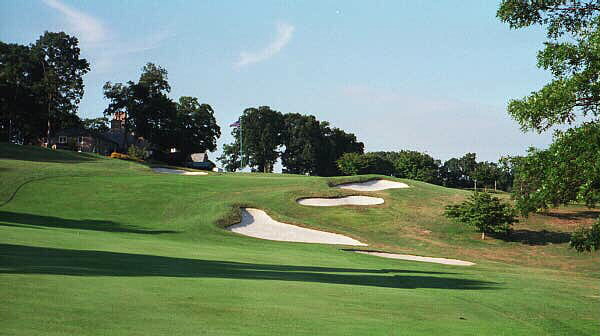
The approach to the 18th green is but one of a number of fascinating approach shots that the golfer will encounter at Huntingdon Valley.
For no good reason, William Flynn has become the most underrated architect in the game’s history. Now that it has become fashionable to sing the praises of Seth Raynor (and well-deserved the praises are), Flynn is mysteriously overlooked in discussions of the noteworthy designers.
As anyone who is fortunate enough to spend time in the Philadelphia area can attest, Rolling Green, Philadelphia Country Club, Manufacturers and Lancaster are all among the country’s top courses. However, perhaps Huntingdon Valley best showcases Flynn’s talent. While Rolling Green has more eye-popping holes and PCC has perhaps the best bunkering in the county, the overall picture at HVCC is the pick of the lot.

Huntingdon Valley enjoys a peaceful setting in its own secluded valley. Pictured above is the idyllic one shot 13th. Flynn dammed the stream in 1927 to create the lake, making it among the first examples of an architect creating a lake to defend a par three green in the United States.
First, Flynn used the unusual property (a wooded bowl with a stream at its bottom) to great effect. The course is in a beautiful, secluded setting — the ideal escape from a day of work in the city. The front nine is routed counter-clockwise around the top of the bowl while the back nine is laid out in a clockwise manner inside the front at the bottom of the slope. While some criticize the routing for being repetitive on the front nine with so many right-to-left slopes, the authors consider the routing to be the course’s strong point. Unlike the first several holes on Baltusrol (Upper), the front nine here gives the player enough room to play his game. Baltusrol practically forces the player to hit fade after fade to hold the sloping fairways and greens, whereas the player here has room to shape the shots as he wishes. Flynn’s routing provides continuity and consistency to each side. Also, as is the case at Muirfield, it is somehow comforting to see the holes during the round that you will play later.
Second, the course has a consistent theme to it: the great majority of greens are canted from one side to the other. It doesn’t take long to figure out that one cannot have a decent score at Huntingdon Valley by consistently missing the greens on the high side. This feature is so refreshing (refreshing for a 65+ year-old course?!?) compared to the predictable back-to-front slope on so many greens on many courses. In fact, the authors wonder if Tom Doak and Gil Hanse borrowed this concept from HVCC for their own Stonewall just west of Philadelphia. At Stonewall almost every green has a definite high side. Players can use these slopes to their advantage or have these slopes make for a very long round. It is infinitely more enjoyable to aim left or right of the hole and watch the green move the ball toward the hole than continually face the same question asked by back-to-front sloping greens.
Third, as noted by David Eger, 1988 Mid-Amateur Champion, the course keeps the player on edge with few level stances in the fairway. However, the slopes are fairly subtle so that the player is not hit over the head with this characteristic. Special note needs to be paid to Green Keeper Scott Anderson and to the Club for their approach to course conditioning.They pride themselves on having the firmest, fastest course in the Philadelphia area (this includes Merion) andare not afraid to see a little brown on the course.Hundreds and hundreds of parkland courses need to follow in their footsteps across the country. As is clearly demonstrated at Huntingdon Valley, firm courses provide for far more thoughtful shotmaking as the player must think about where he wants to land each shot. The player is forced to appreciate the land more and as the Green Comittee chairman remarked, ‘The land is your friend here.’
To top it off, the course has the requisite Flynn attributes: excellent bunkering, often dug into the sides of hills; beautifully-framed green sites and interesting recovery shots to varied greens.
Holes to Note:
2nd hole, 430 yards: A big hole with strategic merit as a drive down the left leaves a much better approach into this green that is angled and slopes from right to left. Flynn placed a key bunker10 paces short and right of the green — you want to land your approach just past it to use the slope effectively.
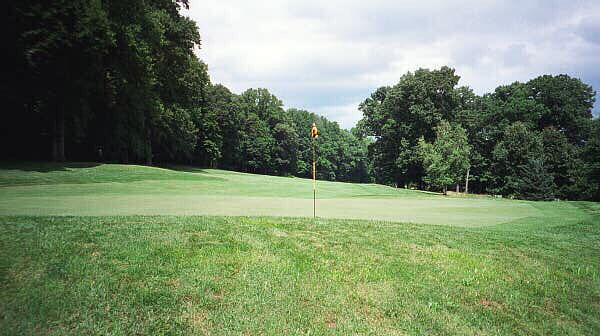
As seen from behind the green, the two principal challenges of the 2nd hole are evident: its right to left sloping fairway and the bunker that is ten paces shy of the high right side of the green.
3rd hole, 210 yards; Given the right to left slope of the terrain, why wouldn’t Flynn & Toomey create a Redan type hole? The answer is they did here at the 3rd. Over the years, the left side of the green has become slightly built up and the Club may elect tolower the left side so that the hole will play exactly as Flynn & Toomey intended.
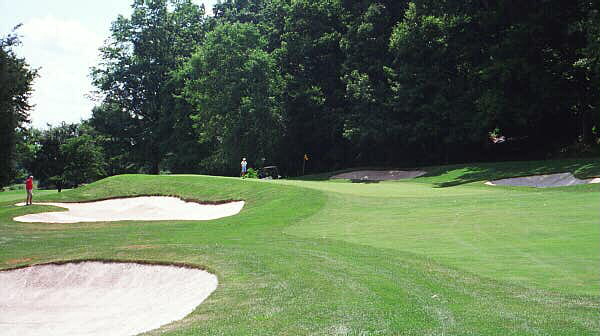
The 3rd green is perfectly benched into the hillside.
4th hole, 365 yards; A strategic gem, this sharply downhilltwo shotter is practically drivable for some under the right conditions. However, beware – the closer one gets to the green, the tighterthe going becomes and a pitch shot from the rough has no chance of staying within 20 feet of any front left hole location.
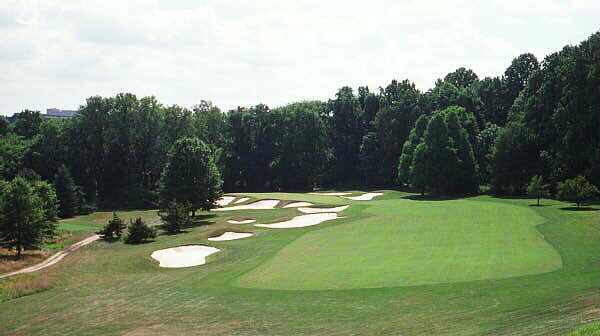
A tee ball that finds the right side of the 4th fairway is ideal.

Given the firmness of the greens, the left rough is no-man’s land on the 4th hole.
6th hole, 440 yards: Plays shorter than it length as it is downhill, but the approach is to one of thefinest greens on the course as it features a drop off to a lower back portion. Hole locations on this lower back portion are a delight to try and get close to but as the golfer quickly learns at Huntingdon Valley, he must use the ground to do so. As at the 2nd, there is a bunker short and right of the green that affects well-played shots more than one would think.

Note the width of the 6th fairway. Will the golfer’s approach shot clear the high right greenside bunker? If so, he will be treated to seeing his ball sweep across the green and toward the hole.
7th hole, 550 yards: A classic three shotter with each shot getting progressively tighter. The clear majority of the time it is a true three-shotter where the drive is the loosest shot (though only by comparison). The player faces the dilemma with his second of whether the reward of getting close enough to the green for a pitch is worth the risk of attempting to fit his second between the bunkers on the right of the narrow fairway and the drop-off on the left. Alternatively, he could lay back to 140 yards where the fairway is wider. However, there is much to be gained by having just a pitch into the green as it is the smallest on the course as well as the firmest. There is yet another well placed bunker short and right of the green that works well on those rare days when there is enough helping wind to encourage players to go for the green in two.
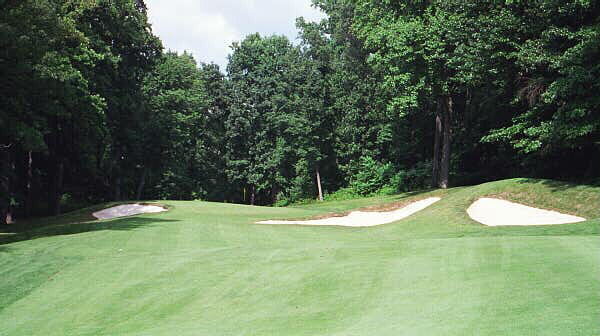
Flynn & Toomey beautifully cut this pair of bunkers into the hillside in front of the 7th green.
10th hole, 400 yards; Whereas the A nine loops counterclockwise around the higher edge of the property, and thus the golfer is faced withright to left slopes to contend with, theB nine starts off in the reverse manner. Flynn angled the green to encourage the approach shot to come in from the left side of the fairway and the green is higher on its left side. The same can be said for the 12th, 14th, 15th, 16th, and 18th holes on this nine in that their greens slope from left to right.Thus, given how the A and B nines perfectly compliment each other, the authors reckon that those two nines create the finer, more balanced test of the three nines, though the C nine is definitely the hardest.
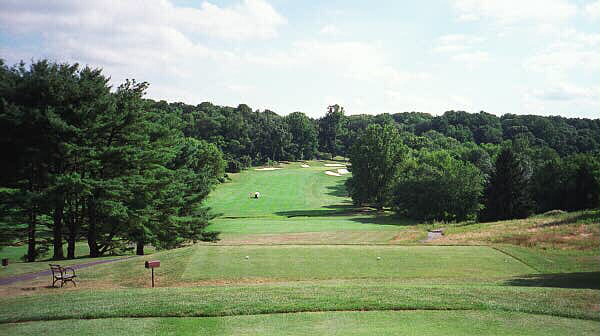
Where the golf cart is, or even slightly left of it, is the ideal angle into the 10th green.
11th hole, 350 yards: Many members’ favorite hole. The tee shot is made tight not by the two bunkers that are at exactly the distance you would like to hit your tee shot but by the trees that interfere with the approach. Depending on the hole location on this wide but shallow, angled green just beyond the creek, there can be only a ten yard gap for playing directly at the hole. A most precise tee shot is required to afford this approach but the hole still works well because of its modest length. Also, this neat, little hole stands out as unique in comparison to Flynn’s other courses in the area.
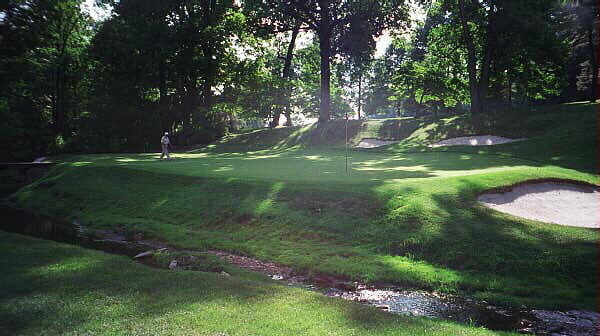
The 11th green is wide from front right to back left but narrow from back to front. In addition, its back to front slope makes any recovery from over the green unlikely, and indeed just keeping the ball on the green is good work.The front right hole location as pictured above is a brute to which to get close.
14th hole, 450 yards: An ideal long par four which features a generous fairway and a beautifully bunkered green with room to miss it (short and left). The credit for this hole belongs to Joe Kirkwood, Huntingdon Valley’s famous long standing professional from the 1930s until the 1960s. Flynn originally had the green some thirty yards to the right but Kirkwood moved it and developed the appealing greenside bunkers and the false front to the green. In the process, Kirkwood oversaw this hole to be an unusually successful conversion of a par five into a par four whilemaking the 15th is a successful conversion of a par four into a par five).
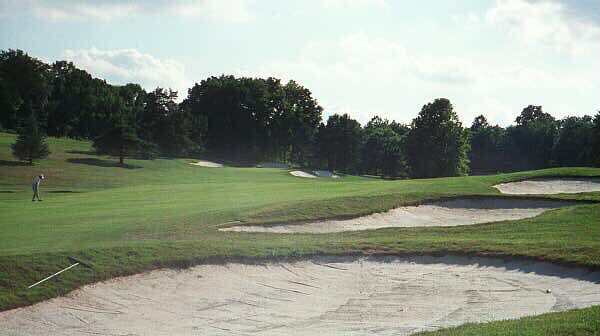
The appealing diagonal bunkers in the 14th fairway must be avoided if…
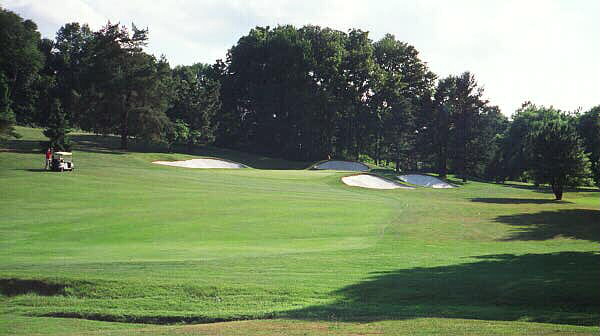
…the green is to be hit in regulation. Note the green’s appealing false front.
18th hole, 435 yards; An inspiring finishing hole that prompted one local golf publication to name it as the finest finishing hole in the greater Philadelphia area (!) , the 18th bends right past a nest of bunkers before finishing at a well placed green at the crest of a hill.

The bold line off the 18th tee must flirt with these bunkers.
19th hole, 450 yards; The first hole on the C nine lets the golfer know straightaway that this nine is different in three respects from the A and B nine: the topography is more abrupt, the holes are consistently bigger in that they are longer and play toward bigger greens, and finallyforced carries are common place. As will be detailed in a November 2001 Feature Interview with Linc Roden, the C ninewas a startling group of holes the day that they opened in 1928. The degree of difficulty posed by these nine holes which measured 3410 yards against a tight par of 35was practically unheard of at the time.
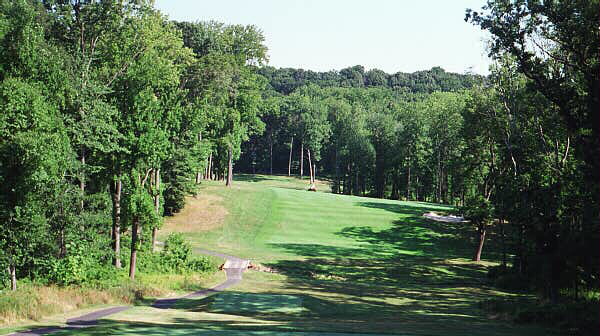
The view from the elevated 19th tee shows the forced carry and the rugged topography that characterize the C nine.
20th hole, 430 yards; Though it is almost impossible to imagine thata hole of this difficulty was built 75 years ago, what is more impressive is how Flynn & Toomey used the land to help the golfer. First, the fairway slopes strongly from right to left and will provide a favorable kick to a flatarea for the uphill approach. In addition, the architects used the back of the hillside to help return approach shots back onto the green.

Looking back from the driving zone in the dogleg to the left 20th hole, the severe rolls in the fairway will help kick the tee ball to the left.
21st hole, 600 yards; Our favorite hole on the C nine for two reasons: its attractive bunkering pattern that edges in from the left rough to capture any loose second shots ala the 16th at Shinnecock Hills and secondly, for the most attractive front to back sweep of the green that makes any approach shot a ticklish matter.
Whichever nines you play, Huntingdon Valley is one of the finest courses to study. The routing is superb and Flynn & Toomey got all the details right. With hardly any room for criticism, the authors scratch their heads as to why more is not heard of this wonderful course. It is that rare combination of difficulty and enjoyment.

The End





![The Park, West Palm (Lit 9) [2023]](https://golfclubatlas.com/wp-content/uploads/2024/12/IMG_7092-2-scaled-500x383.jpg)


